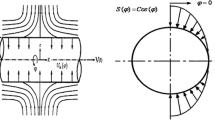Abstract
The ideal gas exhaustion from an infinite volume into a gas at rest through a supersonic conical Laval nozzle is considered. The problem was solved numerically by steadying in time in a unified formulation for the regions inside the nozzle and in the ambient environment. In such a statement, the nozzle outlet section is no internal boundary of the region under consideration, and there is no need of specifying the boundary conditions here. Local subsonic zones arising in the flow lie inside the region under consideration, which eliminates the possibility of using a marching technique along one of the coordinates. The numerical solution is constructed by a unified algorithm for the entire flow region, which gives a possibility of obtaining a higher accuracy. The computations are carried out in the jet initial interval, where, according to monograph [1], the wave phenomena predominate over the viscous effects.
The exhaustion process is described by the system of gas dynamics equations. Their solution is constructed with the aid of a finite difference Harten’s TVD (Total Variation Diminishing) scheme [2], which has the second approximation order in space. The second approximation order in time is achieved with the aid of a five-stage Runge-Kutta method. The solution algorithm has been parallelized in space and implemented on the multi-processor computer systems of the ITAM SB RAS and the MVS-128 of the Siberian Supercomputer Center of SB RAS.
The influence of the semi-apex angle of the nozzle supersonic part and the pressure jump between the nozzle outlet section and the ambient environment on the flow in the initial interval of a non-isobaric jet is investigated in the work. A comparison with experimental data is presented. The computations are carried out for the semi-apex angles of the nozzle supersonic part from 0 (parallel flow) to 20 degrees. For all considered nozzles, the Mach number in the nozzle outlet section, which was computed from the one-dimensional theory, equaled three. Computations showed that in the case of flow acceleration in a conical supersonic nozzle, its geometry is one of the main factors determining the formation of the jet initial interval in ambient environment.
Similar content being viewed by others
References
V.S. Avduevsky, E.A. Ashratov, A.V. Ivanov, and U.G. Pirumov, Gas Dynamics of Supersonic Nonisobaric Jets, Mashinostroenie, Moscow, 1989.
H.C. Yee, R.F. Warming, and A. Harten, Implicit total variation diminishing (TVD) schemes for steady-state calculation, J. Comput. Phys., 1985, Vol. 57, P. 327–360.
U.G. Pirumov and G.S. Roslyakov, Gas Dynamics of Nozzles, Nauka, Moscow, 1990.
V.M. Glaznev, V.I. Zapryagaev, V.N. Uskov, N.M. Terekhova, V.K. Erofeev et al., Jet and Unsteady Flows in Gas Dynamics, SB RAS Publ., Novosibirsk, 2000.
M. Zommerfeld, The structure of particle-laden, underexpanded free jets, Shock Waves, 1994, P. 299–311.
G. Seider, Numerische Untersuchung transsonischer Stromungen, Aerodyn. Inst., RWTH, Aachen, 1991.
A.I. Rylov, Structure of level lines and criterion for similarity of asymptotics in two-dimensional gas flows, Sibirsky Zhurn. Industrialnoy Matematiki, 1999, Vol. 2, No. 1, P. 139–150.
R.F. Cuffel, L.H. Back, and P.F. Massier, Transonic flowfield in a supersonic nozzle with small throat radius of curvature, AIAA J., 1969, Vol. 7, P. 1364–1366.
N.V. Drozdova, U.G. Pirumov, G.S. Roslyakov, and V.P. Sukhorukov, Supersonic gas flows in conical nozzles, in: Some Applications of the Method of Grids in Gas Dynamics. Iss. 6. Gas Flows in Nozzles and Jets, MSU, Moscow, 1974, P. 129–240.
V.I. Zapryagaev, A.V. Kudryavtsev, A.V. Lokotko, A.V. Solotchin, A.A. Pavlov, and A. Hadjadj, An experimental and numerical study of a supersonic jet shock-wave structure, in: West East High Speed Flow Fields 2002, Aerospace Applications from High Subsonic to Hypersonic Regime. A series of Handbooks on Theory and Engng. of Comput. Meth., CINNE, Barcelona, June 2002, P. 346–351.
A.I. Rylov, On the question about the impossibility of regular reflection of steady shock wave from the symmetry axis, Appl.Math. Mech., 1990, Vol. 54,Iss. 2, P. 245–249.
Author information
Authors and Affiliations
Rights and permissions
About this article
Cite this article
Vetlutsky, V.N., Ganimedov, V.L. & Muchnaya, M.I. Influence of the opening angle of a conical supersonic nozzle on the structure of initial interval of non-isobaric jet. Thermophys. Aeromech. 15, 197–203 (2008). https://doi.org/10.1134/S0869864308020030
Received:
Published:
Issue Date:
DOI: https://doi.org/10.1134/S0869864308020030




